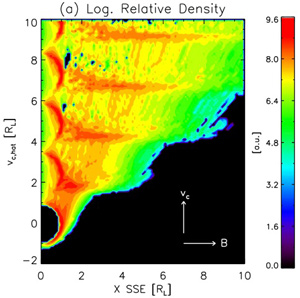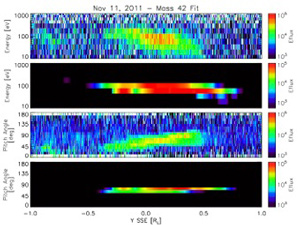2013 ARTEMIS SCIENCE NUGGETS
Model- and ARTEMIS-based constraints on the lunar exosphere
by A. R. Poppe, Space Sciences Laboratory, U.C. Berkeley
Introduction
While our Moon does not possess an atmosphere similar to Earth's, it does have an 'exosphere', which is a tenuous population of neutral atoms extending from its surface out to tens of lunar radii. This exosphere is most likely comprised of many different species that originate from both the solar wind and from the Moon itself; however, most of these species have not yet been observed mainly due their incredibly low densities. The ARTEMIS mission, currently in orbit around the Moon, has remotely observed the lunar exosphere by measuring freshly-ionized pick-up ions coming from the exosphere. These ions are presumably a mix of several species and using a combination of the ARTEMIS measurements and a model of pick-up ion trajectories, we have attempted to constrain the densities of various species thought to be in the exosphere.
Observations
As reported in an earlier paper (Poppe et al., GRL, 2012), the ARTEMIS probes have observed pick-up ions originating near the Moon while the Moon transits the Earth's magnetotail. The magnetotail shields the Moon from the solar wind and in specific regions called the tail lobes, the ambient plasma density can drop by more than a factor of 1000, allowing ARTEMIS to very clearly observe Moon-related pick-up ions. In order to interpret these pick-up ions, we constructed a model of pick-up ion trajectories that included all relevant electromagnetic fields. These fields included the terrestrial magnetic fields, the convection electric field, generated when the terrestrial magnetic fields lines move or "convect" past the Moon, and finally, the electric field present on the surface of the Moon, called the photoelectric field (so-named because solar photons cause the lunar surface to emit electrons and become charged). By then tracing hundreds of thousands of ions from various starting positions near the Moon and allowing them to interact with all the fields in the model, we built a picture of what the density of pick-up ions near the Moon looks like in the magnetotail, shown in Figure 1. In this Figure, the pick-up ion density is predominantly on one side of the Moon, as the ions typically follow the direction that the magnetic field convects. The various ridges and wrinkles in the density are due to a combination of the assumed initial distribution of pick-up ions and their subsequent interaction with both the ambient magnetic field and the lunar surface field.
| Figure 1. The modeled density of lunar pick-up ions in the terrestrial magnetotail lobes. The Moon is at [0,0] in the lower left-hand corner. |
As ARTEMIS orbits around the Moon, it will occasionally pass through the plume of pick-up ions depicted in Figure 1. By using the ARTEMIS trajectory and varying several parameters in the model, we can find the set of parameters that best matches the ARTEMIS observations. For the observation on November 11, 2011 by ARTEMIS P-2, we were able to get the model to match the ARTEMIS observations very well. Figure 2 shows the comparison between the ARTEMIS energy and pitch angle spectra (first and third panels) and the modeled spectra (second and fourth panels). In the upper two panels, the model reproduces both the spatial extent and the energy dependence of the pick-up ions while in the lower two panels, the model reproduces the spatial extent and most of the pitch angle extent of the observations. This match in turn allows us to back out an ion production rate in the lunar exosphere, and from there, we can use photo-ionization rates to determine upper limits to the densities of several exospheric species. While some of the limits we determined were above previously known limits, we were able to constrain the density of four species thought to be in the lunar exosphere: CH4, OH, Al, and Ar. The determination of these upper limits is important in understanding the sources, sinks, and dynamics of such a tenuous neutral exosphere.
| Figure 2. A comparison between the observed and modeled pick-up ion fluxes (in energy and pitch angle) for an observation by ARTEMIS P-2 on November 11, 2011. |
Conclusion
This comparison highlights the utility of using ARTEMIS observations of lunar pick-up ions in the magnetotail to constrain the composition of the lunar exosphere. While ARTEMIS doesn't possess and ion mass composition spectrometer, which would directly measure the ion species, we can nevertheless establish limits on several neutral species thought to be in the lunar exosphere by comparing with our pick-up ion model. Excitingly, the upcoming Lunar Atmosphere and Dust Environment Explorer mission (LADEE) will launch in early September and will spend approximately three months studying the lunar neutral and dusty exosphere environment. We look forward to comparisons of exospheric measurements between LADEE and ARTEMIS.
Reference
Poppe, A. R., R. Samad, J. S. Halekas, M. Sarantos, G. T. Delory, W. M. Farrell, V. Angelopoulos, and J. P. McFadden, ARTEMIS observations of lunar pick-up ions in the terrestrial magnetotail, Geophys. Res. Lett., 39(L17104), 2012Poppe, A. R., J. S. Halekas, R. Samad, M. Sarantos, and G. T. Delory, Model-based constrains on the lunar exosphere derived from ARTEMIS pickup ion observations in the terrestrial magnetotail, J. Geophys. Res. Planets, 118, 1-13, 2013
Biographical Note
Andrew Poppe is a postdoctoral scholar in the Space Physics Research Group at the Space Sciences Laboratory / UC Berkeley. His research includes analysis of ARTEMIS data regarding solar wind and terrestrial magnetotail interactions with the Moon, as well as modeling and data comparison of interplanetary and planetary dust dynamics. See http://sprg.ssl.berkeley.edu/~poppe/ for more information.
 Please send comments/suggestions to
Emmanuel Masongsong / emasongsong@igpp.ucla.edu
Please send comments/suggestions to
Emmanuel Masongsong / emasongsong@igpp.ucla.edu

